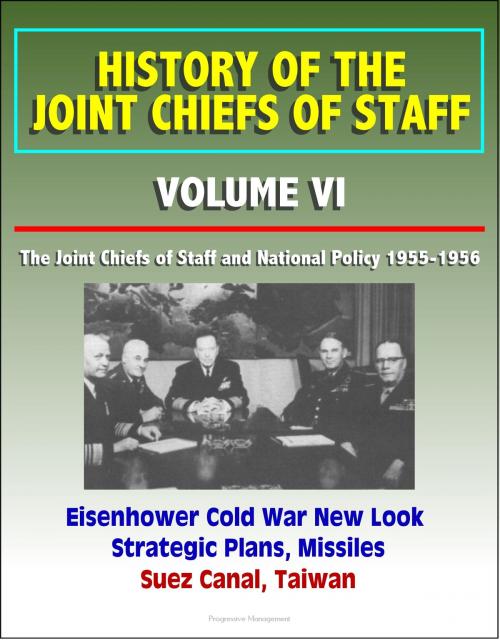History of the Joint Chiefs of Staff: Volume VI: The Joint Chiefs of Staff and National Policy 1955-1956 - Eisenhower Cold War New Look Strategic Plans, Missiles, Suez Canal, Taiwan
Nonfiction, History, Military, Strategy| Author: | Progressive Management | ISBN: | 9781301211746 |
| Publisher: | Progressive Management | Publication: | September 20, 2013 |
| Imprint: | Smashwords Edition | Language: | English |
| Author: | Progressive Management |
| ISBN: | 9781301211746 |
| Publisher: | Progressive Management |
| Publication: | September 20, 2013 |
| Imprint: | Smashwords Edition |
| Language: | English |
When this Volume first saw the light of day some 20 years ago, the United States and the Soviet Union were frozen in one of the most frigid antagonisms of the cold war. Each country was making every effort to develop and deploy the new weapons of mass destruction, to strengthen its own bloc of allies, and to expand its influence and control around the world.
To deal with this potent potential enemy, the Eisenhower administration had redirected its strategy and force planning to emphasize strategic retaliatory striking power. Nuclear weapons delivered by ballistic missiles were the essential components of the New Look, as the policy came to be called. Robert J. Watson has described the JCS role in the creation of the New Look in Volume V of this series.
This Volume VI is primarily concerned with the way the Joint Chiefs of Staff sought to "fine tune" the New Look through strategic plans, the force levels to support them, and allocation of responsibility among the military services for developing and operating the new weapons systems. This turned out to be a contentious process owing to interservice disagreement. Other important matters involving the Joint Chiefs of Staff included the strengthening of NATO, extension of collective security to the Middle and Far East through CENTO and SEATO, commenting on arms control proposals, and helping prepare the military assistance program. Organizational matters, which are the subject of other publications by the Historical Office, are omitted.
- Basic National Security Policy, 1953 * Policy Issues at the Beginning of 1953 * Early Decisions of the New Administration * A New Statement of National Security Policy: NSC 153/1 * Project Solarium * The New Joint Chiefs of Staff and Their Recommendations * A New Policy Directive: NSC 162/2 * Military Strategy Reexamined: JCS 2101/113 * Differences among the Joint Chiefs of Staff * The New Look and Its Interpretation * 2. Basic National Security Policy, 1954 * Framework of Policy Discussion in 1954 * NSC 162/2 and the FY 1956 Budget * JCS Appraisal of Free World Military Posture * First Budget Guidelines * JCS Views on Negotiations with the Soviets * Interim Policy Revision: NCS 5422/2 * Policy Debate Continued * A Revised National Security Policy: NSC 5501 * The Direction of Policy in 1954 * 3. Force Levels and Personnel Strengths * FY 1954 Goals under the Eisenhower Administration * The JCS Interim Look for FY 1955 * The FY 1955 Budget: Impact of the New Look * FY 1956 Plans and the Indochina Crisis * The Issue of Support Force Recommendations * The Decision to Accelerate Retrenchment * Force Levels under the New Ceilings * FY 1956 Defense Budget * Force Levels and Strategy, 1953-1954 * 4. Strategic Planning, 1953-1954 * The JCS Planning Program: Policy Memorandum 84 * Planning at the Beginning of 1953 * Progress of the Joint Strategic Capabilities Plan * Development of the Joint Strategic Objectives Plan * The Joint Long-Range Strategic Estimate * The Planning Program Reconsidered * The First Joint Strategic Capabilities Plan Completed * The Joint Mid-Range War Plan * The 1955-1956 Joint Strategic Capabilities Plan * Revision of the Planning Program * The JCS Planning Program: The First Two Years * 5. Continental Air Defense * Plans, Organization, and Forces for Air Defense * Legacy of the Truman Administration * The New Administration Confronts a Dilemma * Service and Continental US Defense Planning Group Proposals * A New Policy for Continental Defense: NSC 159/4 * Continental Defense and the FY 1955 Budget * Canada's Role in the Early Warning System * A Second Look at Continental Defense Plans * Command and Organizational Changes * The Net Capabilities Evaluation Subcommittee * Northern Canada (Distant Early Warning) Line * Objectives for FY 1956 * Continental Defense at the End of 1954 * 6. Mobilization Planning
When this Volume first saw the light of day some 20 years ago, the United States and the Soviet Union were frozen in one of the most frigid antagonisms of the cold war. Each country was making every effort to develop and deploy the new weapons of mass destruction, to strengthen its own bloc of allies, and to expand its influence and control around the world.
To deal with this potent potential enemy, the Eisenhower administration had redirected its strategy and force planning to emphasize strategic retaliatory striking power. Nuclear weapons delivered by ballistic missiles were the essential components of the New Look, as the policy came to be called. Robert J. Watson has described the JCS role in the creation of the New Look in Volume V of this series.
This Volume VI is primarily concerned with the way the Joint Chiefs of Staff sought to "fine tune" the New Look through strategic plans, the force levels to support them, and allocation of responsibility among the military services for developing and operating the new weapons systems. This turned out to be a contentious process owing to interservice disagreement. Other important matters involving the Joint Chiefs of Staff included the strengthening of NATO, extension of collective security to the Middle and Far East through CENTO and SEATO, commenting on arms control proposals, and helping prepare the military assistance program. Organizational matters, which are the subject of other publications by the Historical Office, are omitted.
- Basic National Security Policy, 1953 * Policy Issues at the Beginning of 1953 * Early Decisions of the New Administration * A New Statement of National Security Policy: NSC 153/1 * Project Solarium * The New Joint Chiefs of Staff and Their Recommendations * A New Policy Directive: NSC 162/2 * Military Strategy Reexamined: JCS 2101/113 * Differences among the Joint Chiefs of Staff * The New Look and Its Interpretation * 2. Basic National Security Policy, 1954 * Framework of Policy Discussion in 1954 * NSC 162/2 and the FY 1956 Budget * JCS Appraisal of Free World Military Posture * First Budget Guidelines * JCS Views on Negotiations with the Soviets * Interim Policy Revision: NCS 5422/2 * Policy Debate Continued * A Revised National Security Policy: NSC 5501 * The Direction of Policy in 1954 * 3. Force Levels and Personnel Strengths * FY 1954 Goals under the Eisenhower Administration * The JCS Interim Look for FY 1955 * The FY 1955 Budget: Impact of the New Look * FY 1956 Plans and the Indochina Crisis * The Issue of Support Force Recommendations * The Decision to Accelerate Retrenchment * Force Levels under the New Ceilings * FY 1956 Defense Budget * Force Levels and Strategy, 1953-1954 * 4. Strategic Planning, 1953-1954 * The JCS Planning Program: Policy Memorandum 84 * Planning at the Beginning of 1953 * Progress of the Joint Strategic Capabilities Plan * Development of the Joint Strategic Objectives Plan * The Joint Long-Range Strategic Estimate * The Planning Program Reconsidered * The First Joint Strategic Capabilities Plan Completed * The Joint Mid-Range War Plan * The 1955-1956 Joint Strategic Capabilities Plan * Revision of the Planning Program * The JCS Planning Program: The First Two Years * 5. Continental Air Defense * Plans, Organization, and Forces for Air Defense * Legacy of the Truman Administration * The New Administration Confronts a Dilemma * Service and Continental US Defense Planning Group Proposals * A New Policy for Continental Defense: NSC 159/4 * Continental Defense and the FY 1955 Budget * Canada's Role in the Early Warning System * A Second Look at Continental Defense Plans * Command and Organizational Changes * The Net Capabilities Evaluation Subcommittee * Northern Canada (Distant Early Warning) Line * Objectives for FY 1956 * Continental Defense at the End of 1954 * 6. Mobilization Planning















